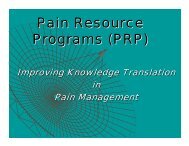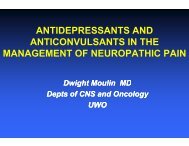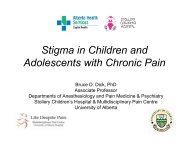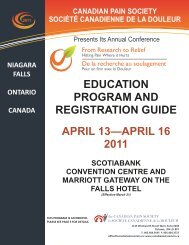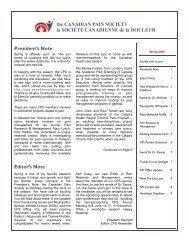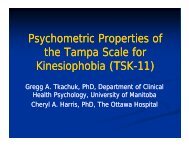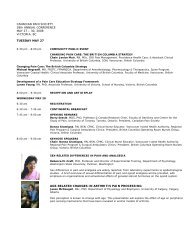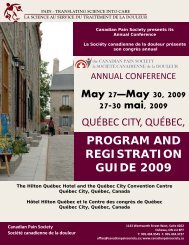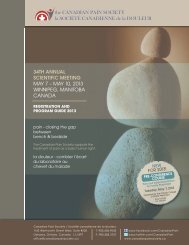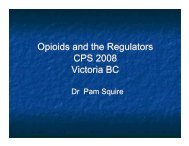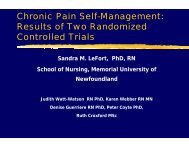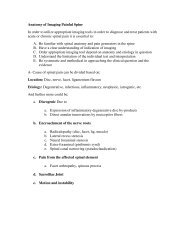Evaluating Neuropathic Pain - The Canadian Pain Society
Evaluating Neuropathic Pain - The Canadian Pain Society
Evaluating Neuropathic Pain - The Canadian Pain Society
You also want an ePaper? Increase the reach of your titles
YUMPU automatically turns print PDFs into web optimized ePapers that Google loves.
<strong>Evaluating</strong> <strong>Neuropathic</strong> <strong>Pain</strong>:Where are we now and whereare we going?Pam Squire, MD CCFPClinical Assistant ProfessorDept of MedicineUniversity of British Columbia
Workshop Objectives• To discuss the newly proposed definition andevaluation of neuropathic pain and the role of QST• To review the neurophysiology of QST and itsclinical relevance• To demonstrate bedside quantitative sensory testingand set the stage for a discussion of future regardingthe usefulness of this tool in clinical practice
Disclosure• Received honoraria or consultation feesfrom the following companies:Janssen Ortho, Paladin, Biovail,Lobopharm,Pfizer,Purdue,Ortho Biotech,Bayer, Valeant,Ortho McNeil, MerckFrosst, Proctor and Gamble & GSK
Where have we come from:neuropathic pain measurement.1998: (<strong>Pain</strong> and Suffering in HistoryミNarratives of Science, MedicineandCulture," which took place 13-14March 1998.Darling BiomedicalLibrary UCLA)– McGill <strong>Pain</strong> Questionnaire– Facial expressions– Happy/sad face graphic pain scale used with pediatric patients– Analog scale for patient self-assessment2008– McGill <strong>Pain</strong> Questionnaire (and many more specific to age/culture)– Multiple NeP pain scales (screen and quantify)– VAS/NRS/Facial expressions (pictures/photos)– Multiple standardized tools to assess the biopsychosocialexperience of pain
Where have we come from?• Evolving definition of neuropathic pain
Definition of Terms• <strong>Neuropathic</strong> <strong>Pain</strong>:1994“<strong>Pain</strong> initiated or caused by a primarylesion or dysfunction in the nervoussystem”Merskey H, Bogduk N, eds. Classification of2nd ed. Seattle, Wash: IASP Press; 1994:209-214Chronic <strong>Pain</strong>.
Problems with current definitionof neuropathic pain“<strong>Pain</strong> initiated or caused by a primarylesion or dysfunction in the nervoussystem”1.What is a dysfunction?2.Which disease?
• <strong>Neuropathic</strong> <strong>Pain</strong>:Definition of Terms“<strong>Pain</strong> initiated or caused by a primarylesion or dysfunction in the nervoussystem”Merskey H, Bogduk N, eds. Classification ofChronic <strong>Pain</strong>. 2nd ed. Seattle,Wash: IASP Press; 1994:209-214“<strong>Pain</strong> arising as a directconsequence of diseases affectingthe somatosensory system”IASP NeuP SIG 2007 – Treede RD, Jensen TS, et al.<strong>Neuropathic</strong>pain: redefinition and a grading system for clinical and researchpurposes.Neurology. 2008 Apr 29;70(18):1630-5. Epub 2007 Nov14.
Challenges in Diagnosing<strong>Neuropathic</strong> <strong>Pain</strong>– Diverse symptomatology 1– Multiple mechanisms 1– Difficulties in communicating and understandingsymptoms• Patients may find it difficult to articulate their symptoms clearly• Physicians may find it difficult to interpret some of the terminologypatients use to describe their symptoms– Variable response to treatment 21. Woolf CJ, Mannion RJ. Lancet. 1999;353:1959-642. Bonezzi C, Demartini L. Acta Neurol Scand Suppl. 1999;173:25-3
NeuPSIG RecommendationsGrading System:DefiniteProbablePossible(Unlikely)
Grading SystemCriteria to be evaluated for each patient:1.<strong>Pain</strong> with a distinct neuroanatomically plausible distribution2.A history of a relevant lesion or disease affecting the peripheral orcentral somatosensory system3.Demonstration of the distinct neuroanatomically plausibledistribution by at least one confirmatory test4.Demonstration of the relevant lesion or disease by at least oneconfirmatory testGrading of certainty for the presence of neuropathic pain:Definite neuropathic pain all (1-4)Probable neuropathic pain 1 and 2 plus either 3 or 4Possible neuropathic pain 1 and 2 without confirmatory evidence from 3 or 4
Grading system: Criterion 11.<strong>Pain</strong> with a distinct neuroanatomically plausibledistribution.A region corresponding to a peripheral innervationterritory or to the topographical representation of abody part in the central nervous systemSuggested tool: pain diagram drawn by the patient
Coloured <strong>Pain</strong> Drawing<strong>Pain</strong> drawing keydull aching -yellowsharp - redtingling - greenburning - blue
Grading system: Criterion 22.A history of a relevant lesion or disease affecting theperipheral or central somatosensory system<strong>The</strong> lesion or disease is reported to be associated with pain,including a temporal relationship typical for the condition.Suggested tool: medical history +/- neuropathic pain scales
SCALESDifferentiate between NP andnon -NP painMeasure characteristics ofNP−Leeds Assessment of <strong>Neuropathic</strong>Symptoms and Signs (LANSS)−<strong>Neuropathic</strong> <strong>Pain</strong> Scale (NPS)−<strong>Neuropathic</strong> <strong>Pain</strong> Questionnaire(NPQ)−<strong>Neuropathic</strong> <strong>Pain</strong> Questionnaire(NPQ)−<strong>Neuropathic</strong> <strong>Pain</strong> DiagnosticQuestionnaire (DouleurNeuropathique en 4 questions,DN4)−<strong>Neuropathic</strong> <strong>Pain</strong> SymptomInventory (NPSI) (French)−ID-<strong>Pain</strong>
Grading system: Criterion 33.Demonstration of the distinct neuroanatomically plausibledistribution by at least one confirmatory testAs part of the neurological examination, these tests confirmthe presence of neurological signs concordant with thedistribution of pain.Suggested tools:Clinical neurological examQuantitative sensory testing (evidence of sensory loss orgain in the area of pain)Electrophysiology• electroneurography (sensory nerve conduction)• evoked potentials (SEP, LEP)
Grading system: 44.Demonstration of the relevant lesion or disease by at leastone confirmatory testAs part of the neurological examination,these tests confirmthe diagnosis of the suspected lesion or disease.Which testsdepends on which lesion or disease is causing neuropathicpain.Confirmatory tests:IHS criteria for trigeminal neuralgiaCSF analysisMRIElectrophysiology (motor/sensory electroneurography)Intraoperative neuroanatomical evidenceBiopsy
Sensory Examination Goals• To test each type of nerve fiber looking forevidence of damage or dysfunction• Determine the pattern of loss– Nerve fibers– Distribution - radicular loss/ gloves and stocking /peripheral neuropathy etc..• To evaluate for both sensory loss AND sensorygain• To help delineate disease mechanisms
Limitations of QSPT• No gold standard for comparison• Testing at one site cannot determine the neuroaxiallevel of dysfunction• Cold hypoalgesia, heat hypoalgesia andmechanical hyperesthesia difficult to diagnose asthe confidence limits are close to the limits of thepossible data range• Paradoxical heat sensation and dynamicmechanical allodynia are unimodal parameters(both signs are normally absent so they cannot bereduced)• Need an unaffected body part to provide normalreference dataP h h i l li i i
How is Quantitative Sensory <strong>Pain</strong>Testing different that what I amdoing now?• Offers a standardized approach to sensory testingand evaluates all the sensory fibers• Evaluates and quantifies both sensory loss andsensory gain• Allows mapping of affected areas which helps todetermine pattern of loss• <strong>The</strong> Question?– Should this be a standardized exam with standardizedtools for consulting pain physicians?
QSPT as a diagnostic and amonitoring tool• Identify loss of function in A Beta (touchand vibration)• Identify loss of function in A Delta and C(<strong>The</strong>rmal and pinprick)• Assess efficacy of lidocaine infusions
Conclusions• We still don’t know (or can’t define) what neuropathicpain really is.• We still can’t really measure it.• Treatment outcomes have been slow to improve.• Quantitative measurements of symptoms and signs offeran opportunity to improve our measurement ofneuropathic pain• Adoption of simple bedside techniques to evaluatesensory signs of neuropathic pain can lead to improveddiagnosis of neuropathic pain
Thank You!
Neurophysiological Basis of QSTand its Clinical Relevance<strong>Canadian</strong> <strong>Pain</strong> <strong>Society</strong>Victoria, BCMay 29 th 2008Serge Marchand, Ph.D.Université de Sherbrooke, Faculté de médecine, Neurochirurgie
Disclosure• Received honoraria or consultation feesfrom the following companies:Janssen Ortho, Astra Zeneca,Pfizer,Purdue,Valeant, Merck FrosstUniversité de Sherbrooke, Faculté de médecine, Neurochirurgie
Objectives• To review the neurophysiology of QST and itsclinical relevance• Review the basis of mechanistics approach topain treatment based on QSTUniversité de Sherbrooke, Faculté de médecine, Neurochirurgie
FromNociception to<strong>Pain</strong>PAIN3Aδ, C2127
Primary afferent axonsBasbaum, NATURE, 2001
First and Second <strong>Pain</strong>CAδ1 st <strong>Pain</strong>Ouch ! pinprick 2 nd <strong>Pain</strong>ouhhhhh ! burning !Couhhhhh ! burning !GarotTourniquetCapsaicineCapsaicineOuch ! pinprickAδ
QST testing of peripheral fibersA-β : Vibration detection thresholdA-δ : Cold detection thresholdC: Heat and Heat pain detection
Secondary nociceptors: Dorsal Horn
Secondary nociceptive neuronsWide Dynamic RangeAαβ, Aδ et CWide dynamic rangeneuron activityBrasseur (1997) fig.2-4a32
Temporal summationCMécanisme centralAδ
Moyenne de la sommation temporelle de20 sujets sainsTemporal Summation Healthy Subjects7060NMDA ?Douleur EVA504030avantimmersion2046C1000 0,2 0,4 0,6 0,8 1 1,2 1,4 1,6 1,8 2 2,2 2,4 2,6 2,8 37,2 secTemps (minutes)Time (minutes)Température cible
QST of central sensitizationTemporal sommation:- Repeated stimulation (pin prick or thermal st) willproduce escalating pain- Persistent pain after the stimulation
FromNociception to<strong>Pain</strong>PAIN3Aδ, C2136
Four major regionsactivated by painCCInsula
Limbic SystemInfluences of :ExpectationEmotionsAnxiety…
. . . <strong>The</strong> brain does not share the construct . . . that the medicalprofession would like to impose on it.. . . it is likely to be simpler . . . with greater emphasis on the psychologicalcontext of the pain and the pathophysiological mechanisms resulting in itsmaintenance.
Inhibition vs facilitation
Endogenous <strong>Pain</strong>InhibitionDescending SystemsDiffuseNoxious2InhibitorySystem
Moyenne de la sommation temporelle de20 sujets sainsTemporal Summation Healthy Subjects7060Douleur EVA50403045%avantimmersion201046Caprèsimmersion00 0,2 0,4 0,6 0,8 1 1,2 1,4 1,6 1,8 2 2,2 2,4 2,6 2,8 37,2 secTemps (minutes)Time (minutes)Température cible
Temporal Summation inMoyenne de la sommation temporellePatients fibromyalgiquesFibromyalgia706050avantimmersionDouleur EVA4030201044Caprèsimmersion00 0,2 0,4 0,6 0,8 1 1,2 1,4 1,6 1,8 2 2,2 2,4 2,6 2,8 37,2 secTemps (minutes)Température cible
Dysfunction of DNIC :Is it a generalized effectof all chronic pain conditions ?- Deficits of DNIC in Tension-Type Headache (Pielsticker, PAIN 2005)- Deficits of DNIC in IBS (Wilder-Smith,C.H., GUT 2004)- No deficit of DNIC in Low Back <strong>Pain</strong> (Julien etal., PAIN 2005)
Medications for neuropathic painCentral sensitizationCa 2+GabapentinLamotrigineLevetiracetamOxcarbazepinePregabalinDescending inhibitory pathways(NE/5HT, opioid receptors)Alpha adrenergic agentsOpioidsSNRIsSSRIsTramadolTCAsCannabinoidsNMDADextromethorphanKetamineMethadoneMemantineCannabinoidsPeripheral mechanismsCarbamazepineLamotrigineLidocaineOxcarbazepineTopiramateTCAsCannabinoidsNE: norepinephrine; 5HT: 5-hydroxytryptamine; NMDA: N-Methyl D-Aspartate;SNRI: selective norepinephrine reuptake inhibitor; SSRI: selective serotonin reuptake inhibitor; TCA: tricyclic antidepressantsNa +
Types of <strong>Pain</strong>Nociceptive: somatic, visceralInflammatoire: somatic, visceralNeurogenic: peripheral, centralFunctional: hyperactivity, lost of inhibitionWoolf, C.J. <strong>Pain</strong>: Moving from Symptom Control towardMechanism-Specific Pharmacologic Management. Ann Intern Med. 2004Scholz,J., Woolf, C.J. Can we conquer pain?Nature Neuroscience., 2004
Mechanistic classification of <strong>Pain</strong>Type of <strong>Pain</strong> Characteristics MechanismsExample ofpharmacologicaltreatmentsMarchand S<strong>The</strong> physiology of painmechanisms: from the periphery tothe brain.Rheumatic Disease Clinics ofNorth America (In Press): 2008.Nocice ptiveSomatic(tissue injury)Visceral(Irritable bowel,cystitis)Superficial (skin)or deep pain(muscle, fascia,tendon)Constant orcramping, poorlocalization.AutonomicresponsesMechanical,thermal orchemical stimuliVisceraldistensionAcetaminophenNa+ blockersNSAID, steroids,opioidsNSAID,AntispasmodicsInflammatory(musculoskeletal)Localized ordiffuse painhyperalgesia,allodynia.Associated withlocalizedinflammationNSAID, steroidsNe uro genicCausalgia(neuralgia,radiculopathy,CNS lesions)Functional(FM, thalamicsyndromes,Irritable bowelsyndrome)Spontaneous,paroxysmal pain.allodynia,hyperalgesia.Diffuse deeppain,hyperalgesia,allodyniaPeripheral orCNS lesionsDysregulation ofexcitatory orinhibitorymechanisms inCNSAnticonvulsivants,opioids,antidepressantsAntidepressants,anticonvulsivants,opioids,cannabinoids.
Individual differencesGenetical predispositionEnvironnemental factorsQST !Peripheral neuropathy-Cold hyperalgesia: C-Hot hyperalgesia: AδCentral sensitization- Temporal summation- Persistent/spontaneous painDisinhibition- Widespread pain (?)
Current <strong>Pain</strong> <strong>The</strong>rapeuticsApproachesAINS (COX-1 & COX-2)Opiacés (mu agonists)Anticonvulsants (GABA)antidepresseurs (5HT, NA),Ketamine, dextorphane,… (NMDA)Cannabinoids (…)Combinations (opioids + ….)Need for an Algorithm !
MechanisticBasedTreatment3AntidepressantsOpioids…2SGPAMésencéphaleAntidepressants(IRSS, IRSA, tricyclics)Opioids…NRMBulbe rachidienAINSCOXIBSteroidscapsaicineOpioidsCannabinoidsAαA, δ C1Anticonvulsivants antiarythmicsAntagonist –NMDAAINS, COXIBOpioidsTricyclics AntidepressantsCannabinoidsVoies spinothalamiqueet spinoréticulaire
Non-pharmacologicaltreatments3RelaxationCognitive <strong>The</strong>rapies…2SGPAMésencéphaleTENS-AcuDeep MassagesTriggerPoints…NRMBulbe rachidienHotColdMassagesAαA, δ C1TENS-conventionalMassages…Voies spinothalamiqueet spinoréticulaire
ÉtudiantsPhilippe GoffauxStéphane PotvinNancy JulienIsabelle GaumondYannick Tousignant-LaflammeJuliana B .De SuzaGuillaume LéonardStéphanie PagéMarie-France SpoonerWilliam RedmondGeneviève LeducÉmilie Paul-SavoieÉdith NormandPatricia RobichaudCollaborateursPatricia BourgaultChristian CloutierSylvie LafrenayePierre RainvilleGilles LavignePhilippe SarretSupportInstituts de recherche en santé du canada(IRSC)Fonds de recherche en santé du Québec(FRSQ)Réseau de recherche en douleur (FRSQ)Réseau de recherche sur le placebo (IRSC)Americain Fibromyalgia Syndrome Association(AFSA)
Inhibition vs facilitation
Mechanistic classification of <strong>Pain</strong>Type of <strong>Pain</strong> Characteristics MechanismsExample ofpharmacologicaltreatmentsMarchand S<strong>The</strong> physiology of painmechanisms: from the periphery tothe brain.Rheumatic Disease Clinics ofNorth America (In Press): 2008.Nocice ptiveSomatic(tissue injury)Visceral(Irritable bowel,cystitis)Superficial (skin)or deep pain(muscle, fascia,tendon)Constant orcramping, poorlocalization.AutonomicresponsesMechanical,thermal orchemical stimuliVisceraldistensionAcetaminophenNa+ blockersNSAID, steroids,opioidsNSAID,AntispasmodicsInflammatory(musculoskeletal)Localized ordiffuse painhyperalgesia,allodynia.Associated withlocalizedinflammationNSAID, steroidsNe uro genicCausalgia(neuralgia,radiculopathy,CNS lesions)Functional(FM, thalamicsyndromes,Irritable bowelsyndrome)Spontaneous,paroxysmal pain.allodynia,hyperalgesia.Diffuse deeppain,hyperalgesia,allodyniaPeripheral orCNS lesionsDysregulation ofexcitatory orinhibitorymechanisms inCNSAnticonvulsivants,opioids,antidepressantsAntidepressants,anticonvulsivants,opioids,cannabinoids.
QST in clinical practice:a practical demonstration andfeasibility discussionMark A. Ware MBBS MRCP MScMcGill UniversityMontreal, Quebec, Canada
Disclosure• Grant support from Pfizer for development ofQST protocols to <strong>Pain</strong> Centre and honoraria forCME activities
Objectives• Review bedside use of QST procedures• Discussion of clinical implications• Utility of QST in research– German Research Network on <strong>Neuropathic</strong> <strong>Pain</strong>(DFNS, Germany)– <strong>Neuropathic</strong> <strong>Pain</strong> Research Consortium (NPRC, USA)– Not yet subject to formal validation
Background• Sensory examination is routine part of neurological examination– Pattern of neuro abnormalities– Part of complete physical exam• Testing for allodynia and hyperalgesia is not part of formal neurologicalexam training for med students at McGill• Formal QST requires specialized equipment– Results in measurable thresholds• Bedside sensory testing is easy to do– Results in “qualitative” or binary (yes/no) result
Constellation of terms• Sensory gain or loss?– Hypo-– Hyper-– Para-– Dys-– An-• Nature of sign– -esthesia– -algesia (-dynia)– -pathia• Nature of stimulus– Tactile/mechanical vs thermal vs pressure vs vibration– Static vs dynamic
Equipment list• Touch– Cotton ball– Brush: foam or bristle, Somedic– QST: Von Frey hairs• Single fibre• Full set of monofilaments• <strong>Pain</strong>– IV needle, toothpick, safety pin, open paperclip (sharp/dull)– QST: Neuropen (large diameter von Frey hair)• Vibration– Tuning fork (C: 125Hz)– QST: “Vibrameter”, Rydel-Seiffer tuning fork• Temperature– Alcohol on cotton swab– Warm and cool test-tubes of water or tuning fork end– <strong>The</strong>rmal rollers (“Rolltemp” by Somedic)– QST: Medoc <strong>The</strong>rmal analyser (TSA II)• Pressure– Finger (!)– QST: Algometer
Technique• General guidelines:– Ask about sensitivity first! (history, drawings)– No leading questions– Tell them what you are going to do– “Close your eyes”– Establish normal side first– Start from unaffected area and move in toward affected area– Start with least painful stimulus– Watch for nonverbal clues (e.g. grimace, twitch)– Check for sensory gain or loss (“Do you feel this more, less, or the same”)– Record findings in chart (and on patient?)• Use manikin to see changes over time
Temporal summation• 10 repetitive stimuli• Pinprick• 1 per second• Baseline and end of test VAS• Tests for central sensitization– Presence of aftersensations–Wind-up
Light touch• Single touch stimulus (no movement)– Verify touch sensation on normal area– <strong>The</strong>n touch contralateral (affected) side:– “is this more, less or the same”– If more, is it painful?– <strong>Pain</strong> response→ static mechanical/tactile allodynia– If increased but not painful→ static dysesthesia– A-ß-fibre mediated
Light Brush• Most studies use the technique described by LaMotte:– each stroke at a velocity of - 5 cm/s over a distance of l-2 cm– strokes to normal skin and then to region of hyperalgesia.LaMotte RH et al. Journal of Neurophysiology 1991- A -β mediated
Light Brush Interpretation• Increased but not painful = brush dysesthesia : mechanism=sensory pathway spontaneous activity (usually spontaneousactivity in A-Beta afferents)• <strong>Pain</strong>ful = brush allodynia : mechanism = central sensitization and/or central disinhibition
Pressure• Gentle increases in pressure with fingertip pad over musclebelly• Feel for tight bands– Trigger points radiate– Tender points do not• Stop pressure at single smooth arc of nailbed pallor• <strong>Pain</strong> response→ static tactile allodynia
Vibration• Test of A -β function• Test over bony prominences?– Tibial tuberosity, medial malleolus, 1st MTP joint– Or test affected area• Ask subject to describe sensation (and when it stops)• Test devices:– tuning fork (128 Hz)– Rydel-Seiffer (64 Hz)– Vibrameter (Somedic)
Vibration Interpretation• Increased but not painful = vibration dysesthesia : mechanism =peripheral sensitization• <strong>Pain</strong>ful = vibration allodynia : mechanism = central sensitization
Cool and Cold <strong>Pain</strong>• Nerve fiber: Cool = A - δ Cold pain = A Delta and C• Test:– QST uses Medoc TSA system• Cold detection and cold pain thresholds– Medoc <strong>The</strong>rmoroller– no standardized tool for bedside– Ask to compare normal to affected• “more, less or same”
Cool and Cold <strong>Pain</strong> Interpretation• Cool testing (A Delta)– Increased but not painful = cool dysesthesia : mechanism = sensory pathway damageor dysfunction and/or central sensitization– <strong>Pain</strong>ful =cool allodynia : mechanism = central sensitization• Cold pain testing (A Delta/C)– Increased and painful = cold hyperalgesia : mechanism =If there is only loss of theA delta specific fibers then patients develop loss of cool sensation (coldhypoesthesia) which is mediated by these fibers. Paradoxically the thresholdfor cold-pain, which is mediated by polymodal C-nociceptors decreases (coldhyperalgesia).<strong>The</strong> pain is stimulated by cold but is described by the patient ashot and burning. Central sensitization may also play a role.
• Test:Warm and Hot <strong>Pain</strong>– QST uses Medoc TSA system• Heat detection and heat pain thresholds– Medoc <strong>The</strong>rmoroller– no standardized tool for bedside– Ask to compare normal to affected• “more, less or same”• If pain detected compared to normal
Warm and Heat <strong>Pain</strong>Interpretation• Warm testing (C fiber)– Increased but not painful = warm dysesthesia : mechanism =not yet defined– <strong>Pain</strong>ful = warm allodynia : mechanism = central sensitization• Heat pain testing (C and some A Delta))– Increased and painful = heat hyperalgesia : mechanism =peripheral sensitization
Pinprick Evaluation• Evaluation of different tools used toproduce a sharp stimulus demonstrated thatif one examiner tests with a probe tip of0.4mm at an angle
Pin Prick <strong>Pain</strong> (Punctate Mechanical)• Probe size and shape matterGreenspan and McGillis, Somatosens Motor Res 1991• Keep force applied constant, single touch only• A - δ and C fiber mediated
Pin Prick Interpretation• Decreased = mechanical hypoalgesia : mechanism = sensorypathway damage or dysfunction of small fibers• Increased = hyperalgesia : mechanism = peripheral sensitization ofC fibers (if associated with heat hyperalgesia which is alsotransmitted by C fibers ) otherwise - central sensitization / centraldisinhibition• Summation and after sensation indicates central sensitization
Clinical implications• <strong>Pain</strong> validation• <strong>Pain</strong> diagnosis• Insurance claims• <strong>The</strong>rapeutic choice– Rx for neuropathic pain– Are there subtypes of NP?• Issues– Standardization of examiners– Predictive value of bedside test
Thank you!
Acknowledgements•NPRC• Misha Backonja U of Wisconsin• David Walk - U of Minnesota• Ajay Wasan - Harvard U• Charles Argoff - NorthShore U Hospital NYC• Gordon Irving - Swedish Hosp, Seattle• Mark Wallace and Toby Moeller - UC San Diego• Nalini Sehgal - U of Wisconsin
Nerve FibersNerve TypeVelocity(m/s)FunctionA - αA - βA - δBC70-12030-7012-303-150.5 - 2motortouchpressurevibrationpain (pinprick)Temperature (coldthreshold)autonomic fibers<strong>Pain</strong> (H/C/P)temperature (heatthreshold)In: Stoelting RK. Pharmacology and Physiology, 3rd edition 1999
Structure of a Nerve
QST Profiles as z-ScoresRolke, Baron, Maier, Tölle, Treede, DFNS Study Group (2006) <strong>Pain</strong>, 123: 231-243
Electroneurography• Electroneurography, also known as nerve conduction studies (NCS),nerve conduction velocity (NCV), or stimulation myelographic study(SMS), is used to detect the presence of a neuropathy in a particularnerve. Anatomically, there are three conditions that significantlydecrease nerve conduction velocities:* demyelination (loss of myelin covering of the nerve)* conduction blocks (damage that stops continued movement of nerveimpulse)* axonal loss (nerve cell death)
Electroneurography• Evaluates the large sensory fibers (pain andvibration) and the motor fibers• Predominately evaluates loss of function (motorand sensory)• Cannot evaluate the individual fibers in a nerve
Somatosensory EvokedPotentials (SEP)• Measure the electrical signal generated by asensory stimuli• Stimuli used = electrical• Transduced by the mechanical receptors andtransmitted by the large A beta fibers dorsalcolumns,medial lemniscus and their thalamocorticalprojections• Provide a more objective measurement of touchand vibration abnormalities
• <strong>The</strong> problem:Somatosensory EvokedPotentials (SEP)Large fibers (touch/vibration) = large amplitudewavesObscure the waves coming from the small fibersIf only the small fibers are damaged the waveformswill look normal
Laser Evoked Potentials (LEP)• Infra red laser pulses stimulate the small pain andtemperature fibers• Measures loss of function in the small fibers,spinothalamictract, lateral brainstem and thalamo-cortical projections• Most useful for assessing loss of pain sensation(hypoalgesia)• QST more useful for evaluating hyperalgesia and relatedpain mechanisms• Takes 1-2 hours,device is expensive, reimbursementissues……Treede RD.Clinical usefulness of laser-evoked potentials.Clinical Neurophys (2003) 303-314
Definition of Terms<strong>Pain</strong>Spontaneous <strong>Pain</strong>Evoked <strong>Pain</strong>Continuous Intermittent Allodynia HyperalgesiaQSTDetection of sensorylossand sensory gainMechanicalStatic, Dynamic<strong>The</strong>rmal/ChemicalCold, Heat
Multiple <strong>Pain</strong> Symptoms in aPatient with <strong>Neuropathic</strong> <strong>Pain</strong>• Red-burning• Blue-numbness• Green-tingling• Black-aching
Where have we comefrom:treatment outcomes.• 1998:<strong>Neuropathic</strong> pain patients Tx with WHO guidelines:meanpain intensity rating (NRS) 70/100 at admission-28/100 after 3days (Grond S et al.<strong>Pain</strong> 1999)• 2000: “Efficacy of pain treatment was good in 70%,satisfactory in 16% and inadequate in 14% of patients.”(Meuser T et al. Symptoms during cancer pain treatment following WHO-guidelines: a longitudinal follow-up studyof symptom prevalence, severity and etiology.• Meuser T, Pietruck C, Radbruch L, Stute P, Lehmann KA, <strong>Pain</strong> 2001)• 2007:IASP NeuPSIG; “despite following best practice guidelineswith sequential trials of therapy pain will be unrelieved or inadequatelyrelieved in 40-60% of patients with neuropathic pain.” (Dworkin RH,.Pharmacologicmanagement of neuropathic pain: evidence-based recommendations.<strong>Pain</strong>. 2007 Dec)



